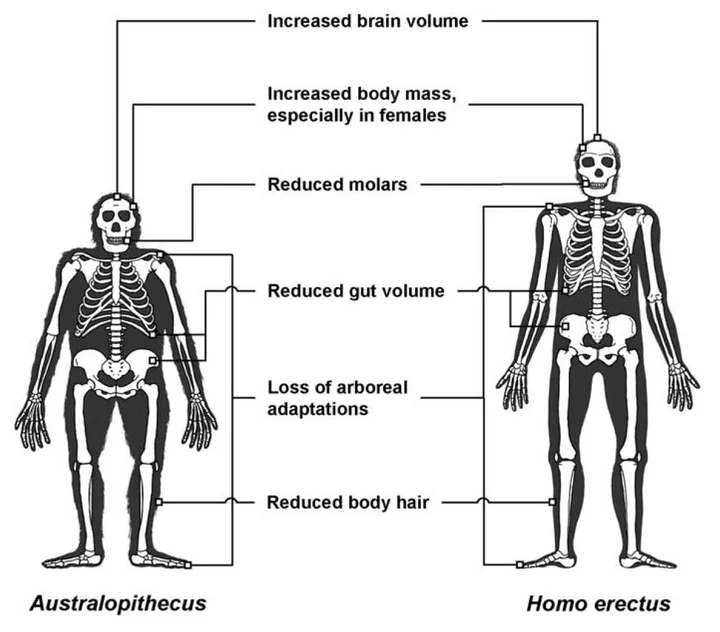Last week, after I claimed that the invention of the basket was a necessary precursor to cooking, several of you objected, saying fires + cooking would have occurred first, and were, anyway, much more important than efficient foraging. After going back and reading what I’d previously written, some years ago, about the importance of cooking, I’m back to say, (gasp) I was probably wrong: cooking led to baskets, not the other way round.
The problem is that, when we’re talking about what happened with our forebears two million years ago, we have tons of speculation and very little actual data to go on.
Data
Between 2.0 and 1.7 million years ago, Homo skeletons changed dramatically. Our two-million-year-old Australopithecus ancestors were apes: they had short stature with a slouching gait, low brows, massive jaws and mouths housing huge teeth, a small (chimpanzee-sized, 37 cubic inches) brain, flared ribs around a big belly and limbs adapted to tree climbing. All the hallmarks, in other words, of a bipedal ape.
Just 300,00 years/20,000 generations later, they had evolved into essentially modern anatomy, Homo erectus. Put one of them into a suit, give them a shave and haircut, and you might be fooled into thinking they were us. They still had a more compact brain than ours (53 vs. 73 cubic inches*), but, compared to Australopithecus, they had much smaller teeth, jaws, mouths, stomachs and colons. Also, their body weight almost doubled, from 75 to 135 pounds.
* Someone figured out that’s equivalent to each generation having 125,000 more neurons than their parents.
Cooking probably got us from Australopithecus (2.0 million years ago) to Homo erectus (1.7 million years ago). (Wrangham-Carmody, used with permission)
Speculation
The catalyst for these dramatic changes was cooking. Cooked meat is essentially pre-digested meat, which, from the POV of our stomach enzymes, is far easier than raw meat to convert into energy; it takes much more time and energy to digest cold, hard, tough food than cooked food.
(Great apes eat twice as much as we do because 30% of their food is indigestible fiber that gets excreted. They spend the better part of their waking lives chewing, while we devote about an hour a day to eating.) This is speculation, because we don’t have archeological evidence that humans controlled fire 1.9 million years ago—the oldest accepted evidence for hearths is only about 250,000 years old. (Neither, of course, do we have millions of years-old baskets—the oldest has been dated to about 10,000 years ago.)
Now comes the interesting part. If you’ve hunted down an animal and you want to cook it, you have to schlep it back to the tribe, because that’s where the fire is. Meaning you have to learn to share it with the whole gang. And if you’re sharing meat, you’re probably a dude (males being anatomically stronger and faster than females), leaving the womenfolk free to go out gathering berries and roots. (There’s limited evidence that foraging was more efficient, in terms of net calories per day, than hunting.) And, as I discussed last week, the key to efficient foraging is a basket to carry home the (literal) fruits of your labor.
(If all this piques your interest, do read Catching Fire: How Cooking Made us Human by Richard Wrangham, professor of biological anthropology at Harvard. It’s in the County library.)
Maybe it’s chicken and egg, but I’m backing off the “baskets first-cooking later” scenario. Something happened to our African forebears two million years ago, and, absent aliens, it probably all started when some clumsy guy — I bet it was a dude — accidentally dropped a chunk of raw meat into the fire: the world’s first BBQ.

CLICK TO MANAGE